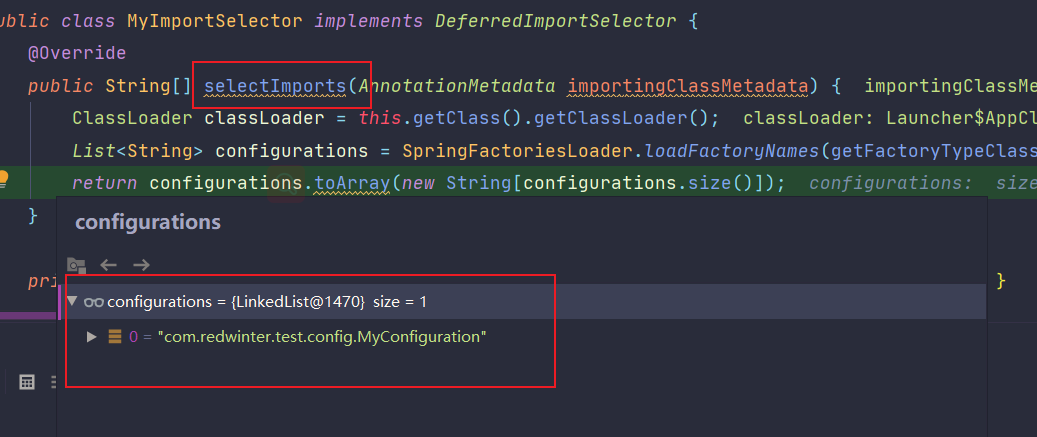Spring 源码(7)Spring的注解是如何解析的?
上一篇 https://www.cnblogs.com/redwinter/p/16196359.html 介绍了BeanFactoryPostProcessor的执行过程,这篇文章介绍Spring中配置的注解是如何通过ConfigurationClassPostProcessor解析的,另外分析下Spring Boot自动装配是如何处理的。
ConfigurationClassPostProcessor 解析了哪些注解?
在上一篇文章https://www.cnblogs.com/redwinter/p/16196359.html 我们知道ConfigurationClassPostProcessor实际上是BeanFactoryPostProcessor的一个实现类,他特殊的地方是他还实现了BeanDefinitionRegisterPostProcessor接口,所以ConfigurationClassPostProcessor 既要实现BeanFactoryPostProcessor的接口方法postProcessBeanFactory也要实现BeanDefinitionRegisterPostProcessor的接口方法postProcessBeanDefinitionRegistry,并且在解析的时候先执行了postProcessBeanDefinitionRegistry方法,再执行了postProcessBeanDefinitionRegistry方法。
接下来我们看看postProcessBeanDefinitionRegistry做了什么?
上源码:
@Override
public void postProcessBeanDefinitionRegistry(BeanDefinitionRegistry registry) {
int registryId = System.identityHashCode(registry);
if (this.registriesPostProcessed.contains(registryId)) {
throw new IllegalStateException(
"postProcessBeanDefinitionRegistry already called on this post-processor against " + registry);
}
if (this.factoriesPostProcessed.contains(registryId)) {
throw new IllegalStateException(
"postProcessBeanFactory already called on this post-processor against " + registry);
}
this.registriesPostProcessed.add(registryId);
// 处理配置的BeanDefinition
processConfigBeanDefinitions(registry);
}
整个方法核心是执行了processConfigBeanDefinitions方法,这个方法非常的长并且逻辑也复杂,代码我就不贴了,说一下大概的流程(较详细):
- 先进行合格的
beanDefinition的检查- 获取到注解的元数据信息
- 判断是包含
@Configuration注解,包含则合格,否则判断是否包含了@Component、@ComponentScan、@Import、@ImportResource注解,包含则合格,如果都不包含则不合格
- 对合格的
BeanDefinition排序 - 创建一个解析
@Configuration注解的解析器 - 对合格的
BeanDefinition集合进行解析- 循环解析,最终调用
processConfigurationClass方法 - 判断是否跳过解析,比如配置了
@Conditional注解的 - 调用
doProcessConfigurationClass方法开始解析(下面的解析中可能会存在递归调用)- 解析
@Component注解- 判断是否包含内部类标记了
@Component,比如在标有@Component注解的类里面创建一个内部类也标记了@Component注解,如果有就会进行递归调用processConfigurationClass方法
- 判断是否包含内部类标记了
- 解析
@PropertySources和@PropertySource注解- 比如标记
@PropertySource("classpath:jdbc.properties"),这样就会把这个属性的值全部解析到环境信息的propertySources属性中
- 比如标记
- 解析
@ComponetScans和@ComponentScan注解- 比如配置了扫描的包,那么就会扫描出合格的
BeanDefinition,然后递归解析
- 比如配置了扫描的包,那么就会扫描出合格的
- 解析
@Import注解(Spring Boot自动装配的实现)- 递归解析出标记了
@Import注解的类放在imports属性中 - 解析
ImportSelector接口的实现类 - 调用
ImportSelector#selectImports方法解析需要注册的类 - 递归调用
processImports方法,然后将需要注册的类注册到importBeanDefinitionRegistrars(这里会在后面进行loadBeanDefinition)
- 递归解析出标记了
- 解析
@ImportResource注解- 比如解析配置的
Spring的xml配置文件,最终放到importedResources属性中(后面会进行loadBeanDefinition)
- 比如解析配置的
- 解析
@Bean注解- 比如解析当前类标记了
@Bean的方法 - 然后放在
beanMethods属性中(后面会进行loadBeanDefinition)
- 比如解析当前类标记了
- 解析
- 加载
BeanDefinition从上面解析出来的类中- 循环遍历加载
BeanDefinition - 判断是否跳过,比如实现了
Condition接口的类 - 加载标有
@Bean的BeanDefinition - 加载从
ImportResource中解析的BeanDefinition - 加载从
ImportSelector中配置的解析的BeanDefinition
- 循环遍历加载
- 循环解析,最终调用
整个过程非常复杂,而且存在递归操作,读者可以按照我写的步骤进行debug调试,当然可能会出现到处跳转不知所措的情况,多调几遍就好了,只要知道大致的流程,应该还是不难的。
总的来说就是解析了这些注解:@Component、@PropertySource、@PropertySources、@ComponentScan、@ComponentScans、@Import、@ImportResource、@Bean,然后将标有这些注解的解析成BeanDefinition,如果加上了@Conditionnal注解,那么按照条件进行解析。

自定义自动装配
现在开发都是用SpringBoot,原因在于他非常的方便,引入即可使用,那么他是做到的呢?众所周知Spring Boot有几个注解非常重要,比如:@SpringBootApplication、@EnableAutoConfiguration、@SpringBootConfiguration,其中最重要的是@EnableAutoConfiguration,这个注解里面标记了@Import(AutoConfigurationImportSelector.class),当然还标记了其他的,我们现在只关心这个@Import,里面放入了一个AutoConfigurationImportSelector类。
AutoConfigurationImportSelector类实现了DeferredImportSelector接口,这个DeferredImportSelector接口是ImportSelector的子接口,表示延迟导入的意思。在上面的分析中,其实最主要的是实现他的接口selectImports,直接源码:
@Override
public String[] selectImports(AnnotationMetadata annotationMetadata) {
if (!isEnabled(annotationMetadata)) {
return NO_IMPORTS;
}
// 获取自动装配的实体
AutoConfigurationEntry autoConfigurationEntry = getAutoConfigurationEntry(annotationMetadata);
return StringUtils.toStringArray(autoConfigurationEntry.getConfigurations());
}
protected AutoConfigurationEntry getAutoConfigurationEntry(AnnotationMetadata annotationMetadata) {
if (!isEnabled(annotationMetadata)) {
return EMPTY_ENTRY;
}
AnnotationAttributes attributes = getAttributes(annotationMetadata);
// 获取合格(候选)的配置
List<String> configurations = getCandidateConfigurations(annotationMetadata, attributes);
configurations = removeDuplicates(configurations);
Set<String> exclusions = getExclusions(annotationMetadata, attributes);
checkExcludedClasses(configurations, exclusions);
configurations.removeAll(exclusions);
configurations = getConfigurationClassFilter().filter(configurations);
fireAutoConfigurationImportEvents(configurations, exclusions);
return new AutoConfigurationEntry(configurations, exclusions);
}
protected List<String> getCandidateConfigurations(AnnotationMetadata metadata, AnnotationAttributes attributes) {
// 加载配置,根据factoryType,这里的FactoryType就是@EnableAutoConfiguration注解
List<String> configurations = SpringFactoriesLoader.loadFactoryNames(getSpringFactoriesLoaderFactoryClass(),
getBeanClassLoader());
Assert.notEmpty(configurations, "No auto configuration classes found in META-INF/spring.factories. If you "
+ "are using a custom packaging, make sure that file is correct.");
return configurations;
}
protected Class<?> getSpringFactoriesLoaderFactoryClass() {
// 直接返回@EnableAutoConfiguration 注解
return EnableAutoConfiguration.class;
}
public static List<String> loadFactoryNames(Class<?> factoryType, @Nullable ClassLoader classLoader) {
String factoryTypeName = factoryType.getName();
// 加载spring.factories文件并解析
return loadSpringFactories(classLoader).getOrDefault(factoryTypeName, Collections.emptyList());
}
private static Map<String, List<String>> loadSpringFactories(@Nullable ClassLoader classLoader) {
MultiValueMap<String, String> result = cache.get(classLoader);
if (result != null) {
return result;
}
try
// 这里获取的url就是:
// public static final String FACTORIES_RESOURCE_LOCATION = "META-INF/spring.factories";
Enumeration<URL> urls = (classLoader != null ?
classLoader.getResources(FACTORIES_RESOURCE_LOCATION) :
ClassLoader.getSystemResources(FACTORIES_RESOURCE_LOCATION));
result = new LinkedMultiValueMap<>();
while (urls.hasMoreElements()) {
URL url = urls.nextElement();
UrlResource resource = new UrlResource(url);
// 读取属性文件,获取到key为EnableAutoConfiguration,value为需要加载的类
Properties properties = PropertiesLoaderUtils.loadProperties(resource);
for (Map.Entry<?, ?> entry : properties.entrySet()) {
String factoryTypeName = ((String) entry.getKey()).trim();
for (String factoryImplementationName : StringUtils.commaDelimitedListToStringArray((String) entry.getValue())) {
result.add(factoryTypeName, factoryImplementationName.trim());
}
}
}
cache.put(classLoader, result);
return result;
}
catch (IOException ex) {
throw new IllegalArgumentException("Unable to load factories from location [" +
FACTORIES_RESOURCE_LOCATION + "]", ex);
}
}
所以我们也可以自己写一个进行自动装配,接下来实现一个简单的自动装配。
定义自动装配注解
/**
* @author <a href="https://www.cnblogs.com/redwinter/">redwinter</a>
* @since 1.0
**/
@Target(ElementType.TYPE)
@Retention(RetentionPolicy.RUNTIME)
@Import(MyImportSelector.class)
public @interface EnableRedwinterAutoConfiguration {
}
创建MyInportSelector类
/**
* @author <a href="https://www.cnblogs.com/redwinter/">redwinter</a>
* @since 1.0
**/
public class MyImportSelector implements DeferredImportSelector {
@Override
public String[] selectImports(AnnotationMetadata importingClassMetadata) {
ClassLoader classLoader = this.getClass().getClassLoader();
// 加载需要装配的类
List<String> configurations = SpringFactoriesLoader.loadFactoryNames(getFactoryTypeClass(), classLoader);
return configurations.toArray(new String[configurations.size()]);
}
private Class<?> getFactoryTypeClass() {
return EnableRedwinterAutoConfiguration.class;
}
}
创建启动类
/**
* @author <a href="https://www.cnblogs.com/redwinter/">redwinter</a>
* @since 1.0
**/
@Configuration
@EnableRedwinterAutoConfiguration
public class RedwinterApplication {
public static void main(String[] args) {
AnnotationConfigApplicationContext context = new AnnotationConfigApplicationContext();
context.scan("com.redwinter.test.config");
context.refresh();
}
}
创建需要装配的类
/**
* @author <a href=""https://www.cnblogs.com/redwinter/">redwinter</a>
* @since 1.0
**/
@Configuration
public class MyConfiguration {
@Bean
@Conditional(RedwinterStrCondition.class)
public String myStr() {
return "redwinter";
}
public static class RedwinterStrCondition implements ConfigurationCondition {
@Override
public ConfigurationPhase getConfigurationPhase() {
return ConfigurationPhase.REGISTER_BEAN;
}
@Override
public boolean matches(ConditionContext context, AnnotatedTypeMetadata metadata) {
System.out.println("开始匹配。。。");
return true;
}
}
}
创建spring.factories文件
com.redwinter.test.config.EnableRedwinterAutoConfiguration=\
com.redwinter.test.config.MyConfiguration
启动验证
debug断点:

这就是Spring Boot自动装配的简化版,总得来说我们完成了Spring 对BeanFactoryPostProcessor的执行过程的解析,包括Spring是如何进行注解解析的,其实就是Spring在对BeanDefinition在正式初始化为Bean的前置处理,所以我们可以这个阶段进行很多扩展,比如占位符的处理PropertySourcesPlaceholderConfigurer等。
接下来接续解读AbstractApplicationContext#refresh方法对BeanPostProcessor的注册。




 浙公网安备 33010602011771号
浙公网安备 33010602011771号